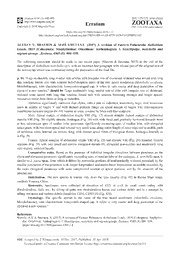
Erratum: ALEXEY V. SHAVRIN & ALEŠ SMETANA (2017) A revision of Eastern Palaearctic Anthobium Leach, 1819 (Coleoptera: Staphylinidae: Omaliinae: Anthophagini). I. Gracilipalpe, morchella and nigrum groups . Zootaxa, 4365 (1): 001–039. PDF
Preview Erratum: ALEXEY V. SHAVRIN & ALEŠ SMETANA (2017) A revision of Eastern Palaearctic Anthobium Leach, 1819 (Coleoptera: Staphylinidae: Omaliinae: Anthophagini). I. Gracilipalpe, morchella and nigrum groups . Zootaxa, 4365 (1): 001–039.
Zootaxa 4410 (3): 600–600 ISSN 1175-5326 (print edition) ZOOTAXA http://www.mapress.com/j/zt/ Erratum Copyright © 2018 Magnolia Press ISSN 1175-5334 (online edition) https://doi.org/10.11646/zootaxa.4410.3.11 http://zoobank.org/urn:lsid:zoobank.org:pub:758DA18B-4AAB-4575-A179-F4A2FBFECC62 ALEXEY V. SHAVRIN & ALEŠ SMETANA (2017) A revision of Eastern Palaearctic Anthobium Leach, 1819 (Coleoptera: Staphylinidae: Omaliinae: Anthophagini). I. Gracilipalpe, morchella and nigrum groups . Zootaxa, 4365 (1): 001–039. The following correction should be made to our recent paper (Shavrin & Smetana 2017) in the end of the description of Anthobium morchella sp.n. with an incorrect last paragraph with missed part of the original text of the manuscript which was overlooked during the preparation of the final file. p. 16. “Legs moderately long; medial side of tibia with irregular row of shortened, widened setae mixed with long thin setation, lateral side with setation be1-Coleoptera name of the true morel mushroom (Morchella esculenta, Morchellaceae), with characteristic honeycomb-shaped cap. It refers to very coarse and deep punctation of the elytra of a new species.” should be “Legs moderately long; medial side of tibia with irregular row of shortened, widened setae mixed with long thin setation, lateral side with setation becoming stronger and longer apicad; metatarsus about three times as long as metatibia. Abdomen significantly narrower than elytra, with a pair of indistinct, moderately large, oval tomentose spots in middle of tergite V and with distinct palisade fringe on apical margin of tergite VII; intersegmental membranes between tergites IV–VII narrow to wide, covered by brickwall-like sculpture. Male. Apical margin of abdominal tergite VIII (Fig. 17) almost straight. Apical margin of abdominal sternite VIII (Fig. 20) slightly sinuate. Aedeagus (Fig. 56) with wide basal part gradually narrowed towards more or less subtruncate apex of median lobe; parameres significantly exceeding apex of median lobe, with elongated apical parts, with two short apical and several very small setae along entire length of inner edge and in middle parts of setiferous lobes; internal sac narrow, long, with distinct apical fields of triangular thorns. Aedeagus laterally as in Fig. 59. Female. Apical margins of abdominal tergite VIII (Fig. 23) and sternite VIII (Fig. 26) rounded. Genital segment (Fig. 29) with very small and narrow elongated sternite IX, elongated gonocoxites and moderately long styli slightly widened basally. Comparative notes. Based on the presence of indistinct irregular elevations between punctures on the elytra and elongated parameres significantly exceeding apex of median lobe of the aedeagus, A. morchella sp.n. is similar to A. puetzi sp.n., from which it differs by postocular portions of head markedly widened posteriad, by the smaller punctation of the pronotum with deeper longitudinal and medio-basal impressions on middle elevation, by the more elongated parameres with more complicated setation of apical portions, and by the structure of the internal sac. Distribution. The new species is known only from the type locality (Fig. 62) in Baima Shan range, northern Yunnan, China. Bionomics. Specimens were collected at elevation of 4225 m a.s.l. in small creek valley with Rhododendron, Salix etc., by sifting of quite wet rhododendron leaves and various debris and in a seepage by sifting wet moss and various debris (localities: C154, C2005-06 (Fig. 63)). Etymology. The specific epithet is the name of the true morel mushroom (Morchella esculenta, Morchellaceae), with characteristic honeycomb-shaped cap. It refers to very coarse and deep punctation of the elytra of a new species.” References Shavrin, A.V. & Smetana, A. (2017) A revision of Eastern Palaearctic Anthobium Leach, 1819 (Coleoptera: Staphylini- dae: Omaliinae: Anthophagini). I. Gracilipalpe, morchella and nigrum groups. Zootaxa, 4365 (1), 001–039. https://doi.org/10.11646/zootaxa.4365.1.1 600 Accepted by J. Klimaszewski: 20 Dec. 2017; Published: 18 Apr. 2018 Licensed under a Creative Commons Attribution License http://creativecommons.org/licenses/by/3.0
